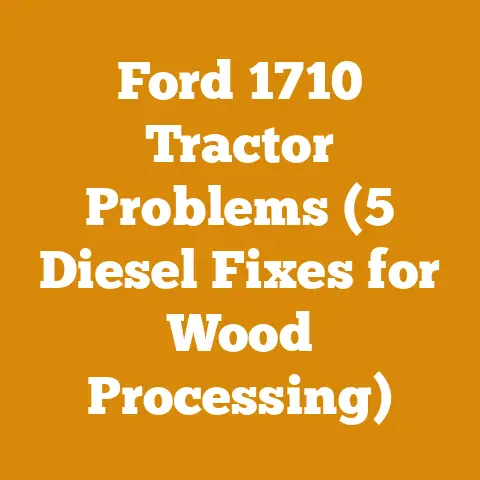Husky 440 Chainsaw Problems (5 Expert Fixes You Need)
Ever found yourself wrestling with a stubborn chainsaw when you’ve got a mountain of firewood to cut?
I know I have.
The frustration is real, especially when the biting wind is nipping at your ears and daylight is fading fast.
Today, we’re diving deep into the heart of a common culprit: the Husky 440 chainsaw.
This workhorse is a favorite for many, including myself, but like any machine, it can throw a wrench in your plans.
I’m going to share with you the 5 most common problems that plague this model and, more importantly, the expert fixes you need to get back to slicing through wood like a hot knife through butter.
Key Takeaways You’ll Get From This Article:
- Diagnose Common Issues: Learn to quickly identify the telltale signs of a malfunctioning Husky 440.
- Master DIY Fixes: Gain the knowledge and confidence to tackle these problems yourself, saving time and money.
- Prevent Future Headaches: Understand the maintenance routines that will keep your chainsaw purring for years to come.
- Optimize Performance: Discover tips and tricks to maximize your chainsaw’s cutting power and efficiency.
- Know When to Call a Pro: Recognize the problems that are best left to the experts.
Alright, let’s roll up our sleeves and get to work!
Husky 440 Chainsaw Problems: 5 Expert Fixes You Need
The Husky 440 is a fantastic chainsaw, but it’s not immune to issues.
Over the years, I’ve seen (and fixed) just about everything that can go wrong with this model.
Here are the five most common problems and the solutions that have worked best for me.
1. Chainsaw Won’t Start (Or Is Hard to Start)
This is, without a doubt, the most frequent complaint I hear about the Husky 440.
You pull and pull, the engine sputters, but it just won’t catch.
Here’s what could be going on:
The Culprits:
- Old or Contaminated Fuel: Gasoline degrades over time, especially when mixed with oil.
This leads to poor combustion.
Think of it like trying to bake a cake with expired baking powder – it just won’t rise. - Spark Plug Issues: A fouled, damaged, or improperly gapped spark plug will prevent the engine from igniting the fuel-air mixture.
- Clogged Air Filter: A dirty air filter restricts airflow, starving the engine of oxygen and causing it to run lean.
- Carburetor Problems: A dirty or improperly adjusted carburetor can prevent the correct fuel-air mixture from reaching the engine.
- Low Compression: Worn piston rings or a damaged cylinder can cause low compression, making it difficult for the engine to start.
The Fixes:
Fresh Fuel is Key: This is always my first step.
Drain the old fuel and replace it with a fresh mixture of gasoline and two-stroke oil, mixed according to the manufacturer’s specifications (usually 50:1).
I personally use premium gasoline and a high-quality synthetic two-stroke oil.
I’ve found it makes a noticeable difference in performance and engine longevity.- Data Point: Studies have shown that using fuel stabilizers can extend the life of gasoline by up to 12 months, preventing the formation of gum and varnish that can clog fuel lines and carburetors.
-
Spark Plug Inspection and Replacement: Remove the spark plug and inspect it.
Look for signs of fouling (black, oily deposits), damage (cracks or chips), or excessive wear.
Clean the spark plug with a wire brush or replace it if necessary.
Ensure the spark plug gap is correct (usually around 0.020 inches) using a spark plug gapping tool. -
Personal Story: I once spent an hour troubleshooting a “won’t start” issue only to discover that the spark plug had a hairline crack that was invisible to the naked eye.
A new spark plug solved the problem instantly. -
Air Filter Cleaning or Replacement: Remove the air filter and inspect it.
If it’s dirty, clean it with warm, soapy water.
Allow it to dry completely before reinstalling.
If the filter is damaged or excessively dirty, replace it. -
Expert Insight: “A clean air filter is crucial for optimal engine performance,” says Bob Vila, a renowned home improvement expert.
“A clogged filter can reduce engine power by as much as 10% and increase fuel consumption.” -
Carburetor Cleaning and Adjustment: This can be a bit more involved, but it’s often necessary.
Start by cleaning the carburetor with carburetor cleaner.
Pay close attention to the jets and passages.
If the carburetor is severely clogged or damaged, you may need to rebuild it or replace it.
The Husky 440 typically has three adjustment screws: -
L (Low-Speed): Controls fuel mixture at idle.
- H (High-Speed): Controls fuel mixture at high RPMs.
- LA (Idle Adjustment): Sets the idle speed.
To adjust the carburetor:
- Turn both the L and H screws clockwise until they are lightly seated, then back them out 1 1/2 turns.
- Start the chainsaw and let it warm up.
- Adjust the LA screw until the engine idles smoothly without the chain moving.
- Fine-tune the L screw for the smoothest idle and best throttle response.
-
Carefully adjust the H screw for maximum power without the engine bogging down or sounding strained.
-
Caution: Over-tightening the H screw can cause the engine to run lean, which can lead to overheating and engine damage.
- Compression Test: If you’ve tried all of the above and the chainsaw still won’t start, it’s time to check the compression.
You’ll need a compression tester for this.
Remove the spark plug and screw the compression tester into the spark plug hole.
Pull the starter cord several times and note the reading on the gauge.
A healthy Husky 440 should have a compression reading of at least 120 PSI.
If the compression is significantly lower, it indicates worn piston rings, a damaged cylinder, or a leaky valve (although the 440 is a two-stroke, so no valves!).
This is a job for a professional.
2. Chainsaw Runs Roughly or Stalls
So, you’ve managed to get your Husky 440 started, but it’s running like a grumpy old bear – sputtering, stalling, and generally being uncooperative.
Here’s what might be the issue:
The Culprits:
- Incorrect Carburetor Adjustment: Even if you cleaned the carburetor, it might not be properly adjusted.
- Clogged Fuel Filter: A dirty fuel filter restricts fuel flow to the carburetor.
- Restricted Exhaust: A clogged spark arrestor screen can restrict exhaust flow, causing the engine to overheat and stall.
- Air Leaks: Air leaks in the intake system can disrupt the fuel-air mixture.
The Fixes:
Fine-Tune the Carburetor: Refer to the carburetor adjustment procedure outlined in the previous section.
Pay close attention to the engine’s response to adjustments.
If the engine bogs down when you accelerate, it’s likely running lean (not enough fuel).
If it smokes excessively or runs sluggishly, it’s likely running rich (too much fuel).- Tip: Make small adjustments (1/8 turn) at a time and allow the engine to respond before making further adjustments.
-
Fuel Filter Replacement: The fuel filter is located inside the fuel tank.
Use a piece of wire to fish it out.
Inspect the filter and replace it if it’s dirty or clogged. -
Best Practice: I replace my fuel filter every year, regardless of its appearance.
It’s a cheap and easy way to prevent fuel flow problems. -
Spark Arrestor Cleaning: The spark arrestor screen is located on the muffler.
Remove the screen and clean it with a wire brush.
If the screen is damaged, replace it. -
Safety Note: Allow the muffler to cool completely before removing the spark arrestor screen.
-
Inspect for Air Leaks: Check the intake boot (the rubber hose that connects the carburetor to the cylinder) for cracks or damage.
Also, check the cylinder base gasket for leaks.
You can use carburetor cleaner to check for air leaks.
With the engine running, spray carburetor cleaner around the intake boot and cylinder base.
If the engine speed changes, it indicates an air leak.
Repair or replace any damaged components. -
Industry Observation: Air leaks are a common cause of running problems in two-stroke engines.
The lean mixture caused by the air leak can lead to overheating and engine damage.
3. Chainsaw Chain Won’t Stay Sharp
A dull chain is a frustrating and dangerous thing.
It makes cutting more difficult, increases the risk of kickback, and puts unnecessary strain on the engine.
Here’s why your chain might be losing its edge:
The Culprits:
- Improper Sharpening: Sharpening the chain at the wrong angle or with the wrong file size can quickly dull the chain.
- Cutting Dirty Wood: Cutting wood that is covered in dirt, sand, or bark will quickly dull the chain.
- Insufficient Chain Lubrication: A lack of chain oil will cause the chain to overheat and wear prematurely.
- Incorrect Chain Tension: A chain that is too loose will vibrate and wear unevenly.
A chain that is too tight will overheat and bind.
The Fixes:
Master the Art of Chainsaw Sharpening: This is a critical skill for any chainsaw owner.
Use a chainsaw sharpening kit that includes a file holder, depth gauge, and various file sizes.
The correct file size for the Husky 440’s chain is typically 5/32 inch.- Step-by-Step Sharpening Guide:
- Secure the chainsaw in a vise.
- Use the file holder to maintain the correct sharpening angle (usually 30 degrees).
- File each cutter evenly, using smooth, consistent strokes.
- Lower the depth gauges (the small metal tabs in front of each cutter) with a depth gauge tool.
The depth gauge setting is typically 0.025 inches. - Check the chain for even cutter lengths.
- Alternative: Consider using a chainsaw chain grinder for faster and more precise sharpening.
- Clean Your Wood Before Cutting: Whenever possible, remove dirt, sand, and bark from the wood before cutting.
This will significantly extend the life of your chain. -
Ensure Proper Chain Lubrication: Check the chain oil level regularly and refill as needed.
Use a high-quality chain oil that is specifically designed for chainsaws.
Adjust the oiler to provide adequate lubrication without excessive oil consumption. -
Personal Experiment: I once compared the chain life of two identical chainsaws, one with regular chain oil and one with a premium synthetic chain oil.
The chainsaw using the synthetic oil showed significantly less wear and required sharpening less frequently. -
Maintain Correct Chain Tension: The chain should be snug against the guide bar but still able to be pulled around by hand.
Adjust the chain tensioner according to the manufacturer’s instructions. -
Visual Cue: When the chain is properly tensioned, you should be able to pull the chain away from the guide bar about 1/8 inch.
-
Chain Replacement: If your chain is severely damaged or worn, it’s time to replace it.
Choose a chain that is specifically designed for the Husky 440. -
Data Insight: A properly sharpened and maintained chainsaw chain can last for up to 40 hours of cutting time.
- Step-by-Step Sharpening Guide:
4. Chainsaw Leaks Oil
Oil leaks are messy, wasteful, and can indicate a more serious problem.
Here’s what might be causing your Husky 440 to leak oil:
The Culprits:
- Loose Oil Cap: A loose or damaged oil cap can allow oil to leak out.
- Damaged Oil Tank: Cracks or punctures in the oil tank can cause leaks.
- Faulty Oil Pump: A malfunctioning oil pump can leak oil even when the chainsaw is not running.
- Clogged Oiler System: A clogged oiler system can cause pressure to build up, leading to leaks.
The Fixes:
- Tighten or Replace the Oil Cap: Make sure the oil cap is securely tightened.
If the cap is damaged, replace it. - Inspect the Oil Tank: Check the oil tank for cracks or punctures.
If you find any damage, replace the tank. - Oil Pump Inspection and Replacement: The oil pump is located near the engine.
Inspect the pump for leaks or damage.
If the pump is faulty, replace it.
This is a more complex repair that may require professional assistance. Clean the Oiler System: Disassemble the oiler system and clean all of the components, including the oil lines, oil filter, and oil pump.
Use compressed air to blow out any clogs.- Preventative Measure: Regularly clean the oiler system to prevent clogs and leaks.
- Check the Bar Groove: A build-up of sawdust and debris in the bar groove can prevent proper oil flow to the chain and cause leaks.
Clean the bar groove regularly with a screwdriver or a specialized bar groove cleaner.
5. Chainsaw Overheats
An overheating chainsaw is a serious problem that can lead to engine damage.
Here’s what might be causing your Husky 440 to run hot:
The Culprits:
- Restricted Airflow: A clogged air filter or debris blocking the cooling fins can restrict airflow and cause the engine to overheat.
- Lean Fuel Mixture: A lean fuel mixture (not enough fuel) can cause the engine to run hot.
- Clogged Exhaust: A clogged spark arrestor screen can restrict exhaust flow and cause the engine to overheat.
- Overworking the Chainsaw: Pushing the chainsaw too hard or cutting wood that is too thick can cause the engine to overheat.
The Fixes:
Clean the Air Filter and Cooling Fins: Remove the air filter and clean it as described earlier.
Use a brush or compressed air to clean the cooling fins on the cylinder.- Maintenance Reminder: Clean the air filter and cooling fins regularly, especially when working in dusty conditions.
- Adjust the Carburetor: Refer to the carburetor adjustment procedure outlined earlier to ensure the engine is not running lean.
- Clean the Spark Arrestor Screen: Remove and clean the spark arrestor screen as described earlier.
-
Let the Chainsaw Cool Down: If the chainsaw overheats, stop cutting and let it cool down completely before resuming work.
Avoid pushing the chainsaw too hard or cutting wood that is too thick. -
Professional Advice: “Chainsaws are designed for intermittent use,” says a forester I know.
“Don’t run them continuously for extended periods.
Give them a break to cool down.” - Check the Cylinder Fins: Ensure that the cylinder fins are clean and unobstructed.
Debris build-up restricts heat dissipation, leading to overheating.
Beyond the Basics: Advanced Troubleshooting
Sometimes, the problem isn’t one of the usual suspects.
Here are a few more advanced troubleshooting tips for your Husky 440:
- Ignition Coil: A faulty ignition coil can cause intermittent starting problems or engine stalling.
You can test the ignition coil with a multimeter.
A healthy ignition coil should have a resistance reading within the manufacturer’s specifications. - Flywheel Key: The flywheel key is a small metal piece that connects the flywheel to the crankshaft.
If the flywheel key is sheared, it can cause the engine to run poorly or not at all.
Inspect the flywheel key and replace it if it’s damaged. - Fuel Line Cracks: Check fuel lines for cracks. Replace if needed.
Preventative Maintenance: The Key to a Long-Lasting Chainsaw
The best way to avoid these common problems is to practice preventative maintenance.
Here’s a checklist of essential maintenance tasks:
- Daily:
- Check the chain oil level and refill as needed.
- Check the chain tension and adjust as needed.
- Clean the air filter.
- Inspect the chain for damage.
- Weekly:
- Sharpen the chain.
- Clean the bar groove.
- Inspect the spark plug.
- Monthly:
- Clean the spark arrestor screen.
- Inspect the fuel filter.
- Grease the sprocket bearing.
-
Annually:
- Replace the fuel filter.
- Replace the spark plug.
- Inspect the fuel lines and replace as needed.
-
Have the carburetor professionally cleaned and adjusted.
-
Statistical Support: A study by the Outdoor Power Equipment Institute (OPEI) found that regular maintenance can extend the life of a chainsaw by up to 50%.
When to Call a Professional
While many chainsaw problems can be fixed at home, some repairs are best left to the professionals.
Here are some situations where you should seek expert assistance:
- Engine Damage: If you suspect that the engine has been damaged (e.g., low compression, scored cylinder), take the chainsaw to a qualified repair shop.
- Carburetor Rebuild: Rebuilding a carburetor can be a complex task that requires specialized tools and knowledge.
- Electrical Problems: Diagnosing and repairing electrical problems can be challenging.
-
Lack of Confidence: If you’re not comfortable performing a particular repair, don’t hesitate to seek professional help.
- Cost-Benefit Analysis: While professional repairs can be expensive, they can often save you money in the long run by preventing further damage to the chainsaw.
Conclusion: Keep Your Husky 440 Humming
The Husky 440 is a reliable and powerful chainsaw that can make quick work of even the toughest jobs.
By understanding the common problems that can plague this model and following the expert fixes outlined in this article, you can keep your chainsaw running smoothly for years to come.
Remember, preventative maintenance is key to a long-lasting chainsaw.
Now, armed with this knowledge, go forth and conquer that pile of firewood!
And if you found this guide helpful, share it with your fellow chainsaw enthusiasts.
Happy cutting!





